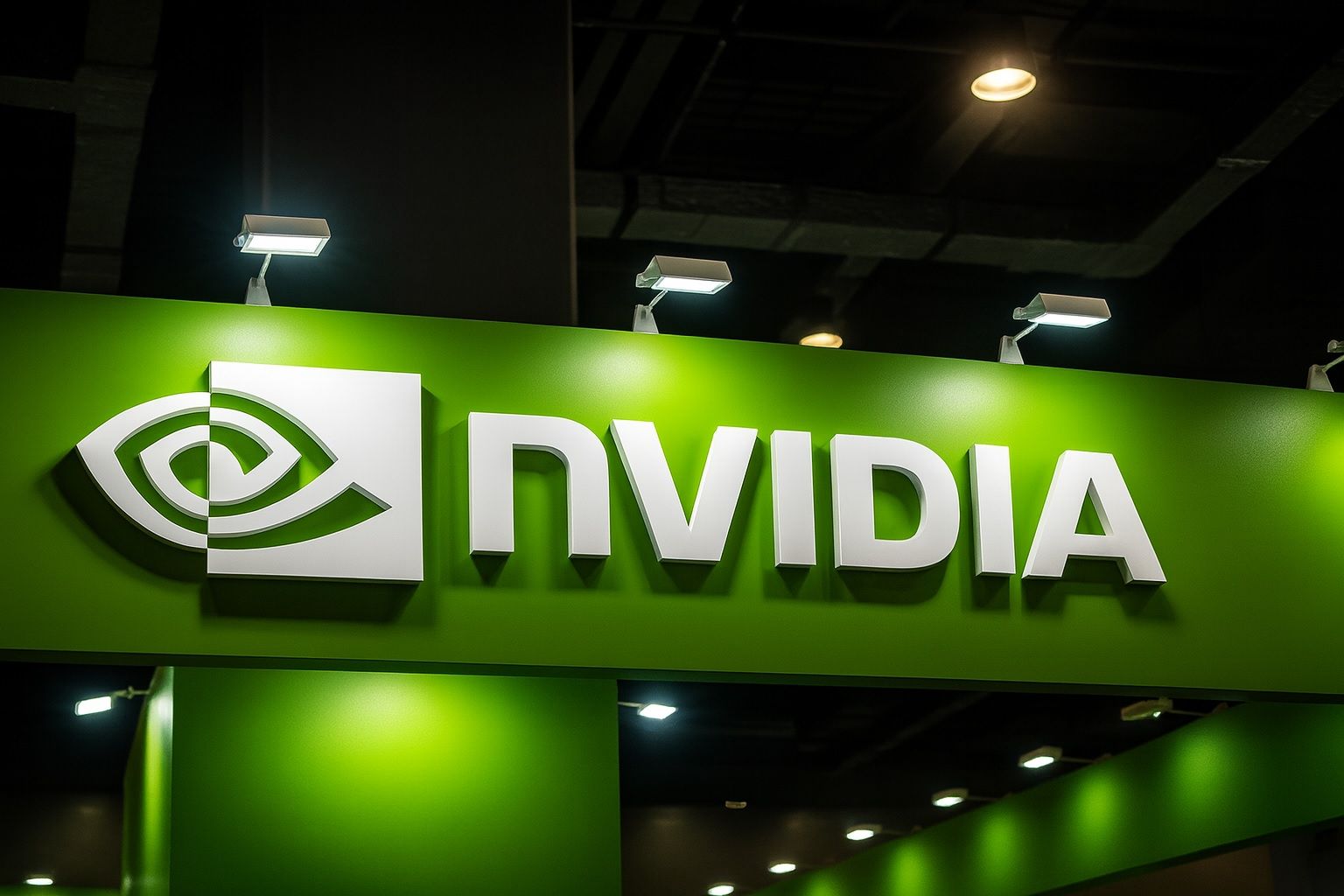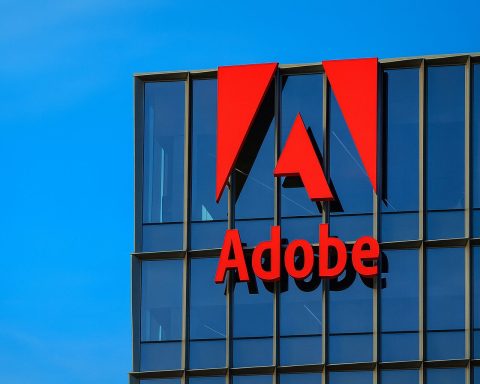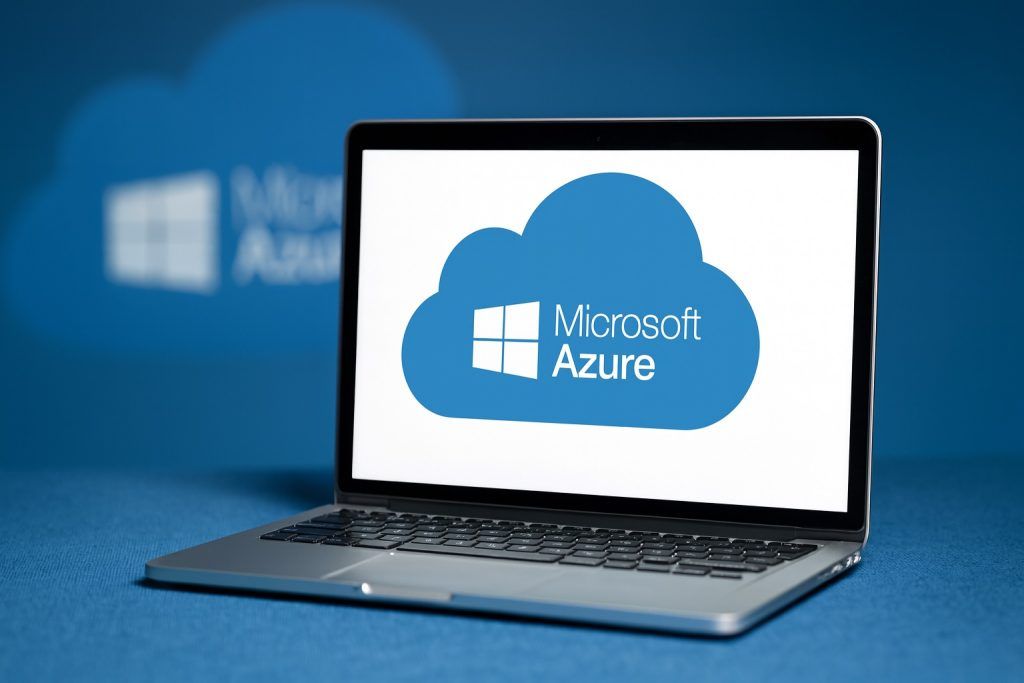- Record Valuation: Nvidia’s stock (NASDAQ: NVDA) surged about 5% on Wednesday, briefly becoming the first company ever to hit a $5 trillion market capitalization [1] [2]. Shares jumped to roughly $210, lifting Nvidia’s value past the milestone and extending its year-to-date gain to roughly 50% [3] – vastly outperforming the broader market amid an ongoing tech rally.
- Recent Price Surge: The stock rallied strongly over the past few days, climbing nearly 3% on Monday (Oct. 27) and 5% on Tuesday (Oct. 28) alone [4]. This week’s surge added hundreds of billions in market value, putting Nvidia on the cusp of the $5T mark before finally breaking through it on Wednesday [5]. By comparison, fellow tech giants Apple and Microsoft only recently crossed the $4 trillion threshold [6] [7].
- Booming Earnings: Soaring demand for AI chips has driven record-breaking financial results. In its latest quarter (FY2026 Q2, covering May–July 2025), Nvidia’s revenue jumped 56% year-over-year to $46.7 billion – an almost unheard-of growth rate for a company of its size [8]. Approximately 88% of sales ($41 billion) came from data-center GPUs used for generative AI, fueling “jaw-dropping” profits (gross margins ~72%, net income up ~59% YoY) [9]. Nvidia has forecast another record quarter ahead (~54% YoY revenue growth to ~$54 billion) and will report earnings on November 19, with Wall Street anticipating “another blockbuster” set of results [10].
- Massive AI Deals: Nvidia has announced unprecedented deals and partnerships to cement its dominance in AI. In late September, the company unveiled a landmark $100 billion agreement with OpenAI to supply at least 10 GW of cutting-edge Nvidia GPUs for OpenAI’s next-gen supercomputing cluster [11]. Nvidia also surprised the industry by investing $5 billion for ~4% stake in Intel to co-develop advanced chips, a move that instantly made Nvidia one of Intel’s top shareholders [12] [13]. Additionally, Nvidia joined a $40 billion consortium (with firms like BlackRock and Microsoft) to acquire Aligned Data Centers – adding about 5 GW of capacity for AI cloud infrastructure [14]. CEO Jensen Huang revealed this week that Nvidia now has a staggering $500 billion in backlogged orders for its AI processors [15] [16]. News of that order book and a U.S. government supercomputer contract sent Nvidia’s stock soaring in recent days.
- New Products & “AI Factories”: The company continues to roll out cutting-edge hardware. Nvidia recently launched its GeForce RTX 50-series GPUs for consumers, featuring AI-enhanced gaming performance, and began shipping DGX Spark, billed as “the world’s smallest AI supercomputer,” for AI researchers [17]. In a milestone for onshoring, Nvidia produced the first test wafers of its next-gen “Blackwell” AI chips at TSMC’s new Arizona fab [18]. The firm is also partnering with companies like Schneider Electric to build large-scale “AI factories” – ultra-efficient data centers powered by 800-volt architecture to support future AI models [19]. And in a major government win, Nvidia will build seven AI supercomputers for the U.S. Department of Energy – part of a slew of announcements that CEO Huang made while touting U.S. tech incentives and leadership [20].
- Competition & Geopolitics: Nvidia’s AI chip dominance is attracting rivals and scrutiny. AMD recently struck a blockbuster deal to supply 6 GW of AI GPUs to OpenAI – a partnership that gives OpenAI the right to acquire up to a 10% stake in AMD – sending AMD’s stock soaring over 34% in a day [21] [22]. Chipmakers Qualcomm and several startups have unveiled new AI chips targeting Nvidia’s turf, and even tech giants like Apple and Google are developing custom AI silicon [23]. So far, however, Nvidia “sells every AI chip it can make” amid red-hot demand, and its lead in software and ecosystems keeps it the industry’s top choice [24] [25]. On the geopolitical front, roughly 10–15% of Nvidia’s revenue comes from China, which is now threatened by U.S. export restrictions on advanced chips [26]. Washington has barred sales of Nvidia’s most cutting-edge GPUs to China, forcing the company to offer slightly watered-down models (like the A800) in that market [27]. President Donald Trump is even expected to discuss Nvidia’s latest AI chip (Blackwell) with China’s President Xi Jinping in an upcoming meeting, as these processors have become a sticking point in U.S.–China tech tensions [28]. Huang has walked a careful line – praising U.S. “America First” policies for spurring domestic tech investment, while warning that cutting off China could deny U.S. firms access to “half the world’s AI talent” [29] [30]. Any new export curbs (or a possible easing of restrictions) from high-level U.S.–China talks in November could significantly impact Nvidia’s outlook [31].
- Analyst Outlook: Despite Nvidia’s steep valuation (now about 50× earnings), Wall Street remains overwhelmingly bullish on the stock. Over 80% of analysts rate NVDA a “Buy,” with 12-month price targets averaging in the low-$200s [32]. Some bulls see even more upside – for instance, HSBC’s top semiconductor analyst recently boosted his target to $320 (nearly 70% above current levels) citing Nvidia as the “backbone” of the AI revolution [33] [34]. One investment firm even speculated Nvidia could eventually reach a $10 trillion market cap in the longer term [35]. “Nvidia hitting a $5 trillion market cap is more than a milestone; it’s a statement,” said Matt Britzman of Hargreaves Lansdown, adding that the market still “underestimates the scale of the opportunity” in AI and that Nvidia remains “one of the best ways to play the AI theme.” [36]. However, a few voices urge caution. A lone contrarian at Seaport Global, for example, argues that Nvidia is “priced for perfection” and likened the current AI frenzy to the dot-com era – “there’s a lot more that can go wrong… than can go right,” he warned, setting a far lower ~$100 target on the stock [37]. Even bullish analysts acknowledge that Nvidia’s towering valuation leaves little room for error, heightening the stakes for its upcoming earnings report [38].
Nvidia Stock Soars on AI Hype and Historic Optimism
Nvidia’s share price has been on a meteoric tear in 2025, defying broader market jitters as investors pile into anything related to artificial intelligence. This week, Nvidia’s stock price jumped repeatedly – nearly +3% on Monday and another +5% on Tuesday – as a flurry of positive news sent traders into a buying frenzy [39]. By Wednesday October 29, the stock rallied to around $209–$210 per share, vaulting Nvidia’s market capitalization above $5 trillion for the first time in history [40]. For context, no company had ever before reached the $5 trillion mark – Nvidia is effectively making history, after having briefly surpassed Apple as the world’s most valuable firm earlier in the month [41].
This record run-up in Nvidia’s value has made it a bellwether for the entire stock market. The company’s huge size means its movements ripple through indexes like the S&P 500 and Nasdaq. Indeed, Nvidia’s surge has helped lift the Nasdaq Composite and S&P 500 to new all-time highs this week [42]. As of Wednesday, the S&P 500 was up ~0.35% and the Nasdaq ~0.66%, with Nvidia among the top drivers of 2025’s market gains [43]. “Momentum and earnings are pushing the market higher,” noted Peter Cardillo of Spartan Capital, pointing out that Nvidia and its Big Tech peers have delivered strong results so far [44]. Cooling inflation and optimism about a more accommodative Federal Reserve have also created a “perfect tailwind” for heavyweight tech stocks like Nvidia [45]. (Notably, investors were awaiting a Fed interest rate cut and a wave of Big Tech earnings as Nvidia hit $5T [46], underscoring how macroeconomic hopes and AI hype have been reinforcing each other).
Analysts attributed Nvidia’s latest spike to a confluence of company-specific news and broader drivers. On Tuesday, CEO Jensen Huang stunned the market by revealing that Nvidia has amassed a $500 billion order backlog for its AI chips and will build seven advanced AI supercomputers for the U.S. government [47] [48]. “In many ways, everything that could have gone right for the firm has gone right over the last 24 hours,” quipped Michael Brown, a market strategist, after Nvidia’s flurry of announcements and the stock’s sharp jump [49]. At the same time, reports of progress in U.S.–China trade discussions – including an upcoming meeting between Presidents Trump and Xi – plus signs of easing inflation have improved overall market sentiment [50]. Nvidia has become a barometer of market optimism: when enthusiasm for AI swells, Nvidia’s stock often leads the charge. Its roughly 12-fold share price increase since the launch of ChatGPT in 2022 has both powered and epitomized the broader tech rally, even igniting debate over whether frothy valuations could be setting the stage for a new bubble [51].
Even with some bouts of volatility, Nvidia’s upward trajectory this year has been remarkable. In mid-October, a spike in interest rates sparked a brief 4% one-day drop in Nvidia (as high-valuation tech names wobbled), but dip-buyers swiftly stepped in [52]. The stock quickly rebounded from the ~$180 level back toward its highs [53]. As of Oct. 29, Nvidia shares were roughly +35% for the year (and an astounding +1,300% since late 2022) [54] [55]. That vastly outpaces the broader market and underscores Nvidia’s status as the premier “AI play” on Wall Street [56]. Notably, Nvidia’s outsized weight in major indexes means its boom has had a disproportionate influence: the company has been among the top boosts to U.S. equities in 2025 [57]. Little wonder that investors are laser-focused on Nvidia’s next moves – at such a towering valuation, any stumble could hit market sentiment hard [58].
AI Gold Rush Drives “Blowout” Earnings Growth
Crucially, Nvidia’s stock surge isn’t based solely on hype – the company’s financial performance has been extraordinary, validating much of the optimism around AI. In its most recent earnings (fiscal Q2 2026 covering May–July 2025), Nvidia shattered expectations with $46.7 billion in quarterly revenue, up 56% from the same period a year earlier [59] [60]. For a company already doing tens of billions in sales each quarter, such growth is almost unheard of. “These results were blowout – truly record-breaking,” said one analyst of Nvidia’s report. To put it in perspective, Nvidia in one quarter generated about what it used to earn in an entire year only a few years ago.
Most of this revenue boom is being driven by insatiable demand for Nvidia’s AI chips. Roughly 88% of last quarter’s sales (about $41 billion) came from Nvidia’s data-center business, which includes the powerful GPU (graphics processing unit) accelerators that train and run modern AI systems [61] [62]. In other words, the ongoing generative AI gold rush – from chatbots like ChatGPT to a multitude of new AI services – is directly translating into a massive market for Nvidia’s hardware. Cloud computing giants, startups, and research labs are effectively racing to buy every high-end GPU Nvidia can produce to build out AI infrastructure.
This wave of demand has made Nvidia wildly profitable. The company enjoys hefty margins on these advanced chips, which face little competition at the top end. Last quarter, Nvidia’s gross profit margin hit ~72%, and it delivered net income of over $26 billion (up ~59% year-on-year) [63] [64]. Such “jaw-dropping” profitability illustrates the tremendous operating leverage in Nvidia’s model: once its fixed costs are covered, each additional dollar of AI chip sales drops mostly to the bottom line [65]. Little surprise, then, that Nvidia’s market cap vaulted past $4.5 trillion this fall amid its earnings bonanza [66]. At one point in early October, investors even briefly bid Nvidia’s valuation higher than Apple’s, making Nvidia the most valuable public company on the planet for a short time [67]. It was a striking moment symbolically – underscoring how a once-niche graphics card maker has transformed into what many see as the backbone of the AI era [68].
Company executives stress that we are still in the “early innings” of the AI boom. “The AI revolution is far from over – in fact, it’s just beginning,” CEO Jensen Huang declared at a recent developer conference [69]. He touted Nvidia’s forthcoming Blackwell generation of GPUs as “the AI platform the world has been waiting for,” noting that customer demand remains “extraordinary” [70]. Backed by these trends, Nvidia has sharply raised its own forecasts. For the current quarter (Aug–Oct 2025), Nvidia guided to roughly $54 billion in revenue, which would mark another ~54% YoY jump [71]. If achieved, Nvidia will have nearly tripled its quarterly sales in just two years – a mind-bending growth trajectory. Wall Street analysts are accordingly predicting another blockbuster earnings report on Nov. 19 [72], though they caution that with expectations so high now, anything short of stellar growth could be seen as a disappointment [73]. As Reuters noted, Nvidia’s lofty valuation “raises expectations and leaves little room for disappointment” going forward [74].
Massive Deals from OpenAI to Intel Secure Future Demand
Faced with nearly limitless appetite for its AI computing platforms, Nvidia has moved aggressively to secure long-term demand – striking gigantic deals and alliances that would have been unimaginable just a few years ago. Most notably, in late September Nvidia announced a partnership of unprecedented scale: a plan to invest up to $100 billion in OpenAI (the creator of ChatGPT) and supply OpenAI with at least 10 gigawatts of Nvidia’s cutting-edge GPUs [75] [76]. In return, OpenAI committed to build its next-generation AI supercomputing infrastructure primarily on Nvidia hardware. “Everything starts with compute,” OpenAI CEO Sam Altman said of the deal, underscoring that Nvidia’s chips will remain “at the heart of future AI breakthroughs.” Analysts estimate that each 1 GW of AI data-center capacity can equate to roughly $50 billion in hardware sales [77] – implying this OpenAI collaboration could be worth on the order of $500 billion in revenue to Nvidia over the coming years if fully realized. The sheer scale of the deal stunned investors (AI enthusiasts dubbed it an “AI arms pact”), and euphoria around the announcement even lifted Nvidia’s stock ~4% in a single day when news of the talks first leaked [78].
Around the same time, Nvidia also unveiled a surprise alliance with Intel, historically one of its biggest rivals in chips. In mid-September, Nvidia agreed to invest $5 billion for roughly a 4% stake in Intel [79] – instantly making Nvidia one of Intel’s largest shareholders – as part of a broader partnership to co-develop new chips for PCs and data centers. The pact was striking: Intel, long the titan of PC processors, has struggled in recent years, and now Nvidia is both a stakeholder and collaborator in its turnaround. The deal will see the two companies jointly design multiple generations of future central processors that pair tightly with Nvidia’s GPUs (though Nvidia stopped short of agreeing to have its own GPUs manufactured by Intel’s foundry, at least for now) [80] [81]. Nvidia’s backing came just weeks after the U.S. government orchestrated an unusual move to take a 10% stake in Intel to bolster the struggling firm [82] [83]. Nvidia’s support offers Intel “a new chance after years of failed turnaround efforts,” Reuters noted, and Intel’s stock price jumped 23% on the lifeline news [84] [85]. “This is a massive game-changer for Intel that effectively resets its position… into a cog in future AI infrastructure,” said one tech analyst about the tie-up [86]. The partnership could pose a long-term challenge to chip foundry leader TSMC (which currently manufactures Nvidia’s flagship chips) and even to AMD, which competes with Intel in supplying data-center CPUs [87]. In the near term, it gives Nvidia influence at another major chipmaker and could ensure more secure supply and technological synergies as AI computing needs expand.
Nvidia didn’t stop there. It also joined forces with a consortium of financial and tech firms – including BlackRock and Microsoft – to acquire Aligned Data Centers for $40 billion [88]. This deal, announced in October, will add roughly 5 GW of data center capacity aimed at AI cloud services [89]. Such capacity expansion dovetails with Nvidia’s strategy of enabling “AI factories” (massive data centers for training AI models). Additionally, Nvidia has been investing in startups and software to bolster its AI ecosystem. It poured money into OpenAI’s rival Cohere and has numerous programs to support AI developers using its hardware. All these moves are about locking in future growth. By securing huge orders and partnerships years out, Nvidia is attempting to extend its dominance for as long as possible. As one market analyst observed, “Nvidia clearly brought their story to D.C. to both educate and gain favor with the U.S. government… They managed to hit most of the hottest and most influential topics in tech,” from national security to AI innovation [90] [91]. The result: Nvidia has positioned itself not just as a chip supplier, but as a strategic pillar for the tech industry’s next era.
New Chips and “AI Factory” Innovations
Keeping its foot on the gas, Nvidia has also been unveiling a stream of new products and technological advances. In October, the company introduced the much-anticipated GeForce RTX 50-series graphics cards for gamers and creators. These next-gen GPUs leverage AI to enhance graphics performance (for example, using AI algorithms to upscale and render realistic visuals in real time). The RTX 50 launch keeps Nvidia’s core gaming audience engaged and shows that despite the focus on data centers, Nvidia hasn’t forgotten its consumer roots. Early previews highlighted substantial performance gains in AI-assisted rendering and physics simulation, which could future-proof Nvidia’s dominance in high-end GPUs [92].
For the AI research community and enterprise customers, Nvidia rolled out DGX Spark, a compact AI supercomputer system. Touted as “the world’s smallest AI supercomputer,” DGX Spark is essentially a powerful server appliance optimized for AI model development, offering organizations a plug-and-play entry into Nvidia’s AI ecosystem [93]. Analysts see this as Nvidia targeting a broader range of AI customers – not every lab or company can build a full data center of H100 GPUs, but a smaller DGX system could bring Nvidia’s AI compute capabilities to university labs, startups, or enterprise R&D groups. It exemplifies how Nvidia is productizing AI at all scales, from cloud data centers down to smaller on-premise units.
Another major milestone: Nvidia has started producing its first U.S.-made “Blackwell” AI chips. Blackwell is Nvidia’s next-generation GPU architecture (set to succeed the current “Hopper” chips like the H100), and it’s expected to be even more powerful. In a win for U.S. manufacturing, Nvidia confirmed it successfully fabricated test batches of Blackwell chips at TSMC’s new Arizona fab [94]. This is largely symbolic for now – the vast majority of Nvidia’s chips are still made in Taiwan – but it marks a step toward geographically diversifying its supply chain. It also aligns with U.S. government efforts (and incentives from the CHIPS Act) to boost domestic semiconductor production. Huang publicly praised these U.S. incentives, noting they accelerate investment in cutting-edge tech on American soil [95].
Nvidia’s vision for “AI factories” is another piece of its future roadmap. The term refers to giant, ultra-efficient data centers purpose-built for AI model training and deployment. Nvidia is partnering with firms like Schneider Electric to design these facilities with an emphasis on power efficiency – using 800-volt electrical architectures and other innovations to handle the immense energy needs of AI computing [96]. By driving advances in data center design, Nvidia aims to ease one bottleneck to AI growth (energy and cooling constraints) and ensure that as demand for AI computing skyrockets, the infrastructure can scale sustainably. In line with this strategy, the U.S. Department of Energy deal Jensen Huang announced isn’t just about selling GPUs; Nvidia will itself build and deliver seven AI supercomputers to DOE labs [97]. These systems will presumably be turnkey “AI factories” using Nvidia’s full stack – from chips to networking to software. It’s a showcase of Nvidia’s end-to-end capabilities, and it nets the company a high-profile government client for years to come. All told, these product launches and projects reinforce how Nvidia is not sitting still even as it dominates the market; the company is pushing the envelope on technology and securing new channels for growth at every level of the AI supply chain.
Competition Intensifies: AMD, Intel and Others Chase the AI Crown
Unsurprisingly, Nvidia’s success has put a target on its back. A growing list of competitors – from industry stalwarts to upstarts – are keen to capture a slice of the booming AI chip market. The most dramatic challenge has come from Advanced Micro Devices (AMD), Nvidia’s longtime GPU rival. In early October, AMD announced a sweeping partnership with OpenAI that in many ways mirrors Nvidia’s approach. AMD will supply OpenAI with roughly 6 GW of its upcoming AI accelerators (the equivalent of hundreds of thousands of GPU chips) starting in late 2025, and in return OpenAI received warrants to buy up to 10% of AMD’s shares at a token price [98] [99]. The news was a huge vote of confidence in AMD’s AI technology – and investors responded with euphoria. AMD’s stock soared over 30% on the deal, its biggest one-day jump in nearly a decade [100] [101]. Analysts called the agreement “transformative” for AMD and a clear signal that OpenAI (and perhaps others) don’t want to rely on a single supplier for critical AI infrastructure [102] [103].
However, despite this landmark win for AMD, experts say it may barely dent Nvidia’s dominance in the near term. Nvidia still offers the most advanced GPUs and software ecosystem, and as noted, it continues to sell essentially every chip it can make. “It’s a major vote of confidence in AMD’s AI chips… but it’s unlikely to seriously erode Nvidia’s lead,” said one chief investment strategist, noting that Nvidia’s market share and execution remain unparalleled [104] [105]. In fact, even on the day of AMD’s big announcement, Nvidia’s stock only dipped ~1% [106] – a sign that investors saw the competitive threat as manageable. The reality is that the AI hardware market is so fast-growing that multiple winners can thrive. AMD projects the OpenAI deal and its ripple effects will bring in over $100 billion in new revenue over four years [107] [108] – huge for AMD, but still likely smaller than Nvidia’s own revenue stream over that period (analysts expect Nvidia to top $200 billion in revenue this year alone) [109]. In short, while AMD is strengthening its hand and could narrow the gap, Nvidia still holds a substantial first-mover advantage.
Beyond AMD, other competitors are circling as well. Qualcomm has rolled out new AI chips aimed at data centers, leveraging its expertise in mobile processors to create power-efficient AI accelerators. A number of well-funded startups – such as Cerebras, Graphcore, and SambaNova – are developing specialized AI chips (some focusing on niche use-cases or offering alternative architectures to GPUs). Big tech companies like Google (with its TPU chips) and Amazon (through its Annapurna Labs’ Inferentia/Trainium chips) are designing custom silicon for AI workloads to use in their own clouds, reducing (though not eliminating) their dependence on Nvidia. Even Apple is reportedly researching AI-focused silicon that could one day compete in certain areas. Nvidia’s CEO Huang has acknowledged that the AI computing “pie” is expanding to multiple players – but he maintains there’s more than enough demand for all, and Nvidia’s aim is simply to stay at the forefront of innovation [110].
One advantage Nvidia holds is its software ecosystem, including the CUDA programming platform and AI libraries that are widely adopted. Competitors often struggle not just to match Nvidia’s hardware performance, but to offer comparable software support to developers. This has created a semi-virtuous cycle favoring Nvidia: most AI researchers and engineers are trained on Nvidia’s stack, so new entrants must do significantly better on price or performance to entice customers to switch.
Meanwhile, geopolitical factors loom large in the competitive landscape. Roughly a tenth or more of Nvidia’s revenue comes from China [111], a market now constrained by U.S. export controls on high-end chips. The Biden Administration (and now the Trump Administration, following the 2024 election) have imposed strict rules preventing cutting-edge Nvidia GPUs – like the A100 and H100, and soon the upcoming Blackwell – from being sold to Chinese clients [112]. Nvidia has navigated this by producing slightly downgraded versions (e.g. the A800) that meet U.S. guidelines and still sell in China, but the restrictions have undoubtedly tempered Nvidia’s China business. CEO Jensen Huang has been vocal about the issue: he supports U.S. efforts to bolster domestic tech (even crediting “America First” policies for helping drive investment in chipmaking and AI) [113] [114], but he also cautions that completely cutting off China could backfire, noting that China houses “half the world’s AI talent” and a huge customer base [115] [116]. The stakes are high – China is aggressively developing its own AI chips to reduce reliance on Nvidia, and U.S. sanctions only accelerate that push. Later this year, President Trump and China’s President Xi are expected to hold talks (at the APEC summit) where chip export policies will be a key agenda item [117]. Any further tightening – or conversely, an easing – of restrictions could significantly sway Nvidia’s growth prospects in Asia.
Finally, it’s worth noting that global regulatory scrutiny is increasing along with Nvidia’s prominence. Trade tensions are one aspect; another is the possibility of antitrust attention if Nvidia’s dominance grows unchecked. Thus far, Nvidia’s main acquisition attempts (such as the failed bid for ARM Ltd. in 2022) have drawn regulators’ ire, and the company may tread carefully on major buyouts going forward. Instead, Nvidia appears to favor strategic investments (like the Intel stake) and partnerships to extend its reach without triggering antitrust alarms.
Wall Street Forecasts: Big Upside – but Bubble Fears Linger
On Wall Street, Nvidia’s astonishing run has bulls and bears debating how much higher it can go. The consensus among analysts is still extremely positive. According to Refinitiv data, over four-fifths of analysts covering Nvidia rate it a “Buy”, and the average 12-month price target sits around $210–$220 per share [118]. That target range implies modest upside from current levels, suggesting that many see the stock’s rapid gains as largely justified by Nvidia’s fundamentals and growth outlook. As one senior analyst put it, “The market continues to underestimate the scale of the opportunity, and Nvidia remains one of the best ways to play the AI theme.” [119] Firms have repeatedly had to raise their estimates as Nvidia keeps blowing past projections.
Indeed, some of the biggest holdouts have turned outright bullish. In mid-October, HSBC’s semiconductor team – which had been skeptical – upgraded Nvidia to “Buy” and jacked up its price target to $320 (from just $200 previously) [120]. That Street-high target implies roughly 60–70% upside from late-October trading levels [121]. HSBC’s analysts cited Nvidia’s dominant position as the “backbone” of AI and projected that the total AI chip market could exceed $350 billion annually by 2027, with Nvidia poised to capture a lion’s share [122]. They also see Nvidia’s earnings skyrocketing over the next two years as production ramps up to meet demand. Likewise, UBS and others have issued fresh upgrades after Nvidia disclosed the $500B in orders for its next-gen Blackwell chips, viewing it as evidence of multi-year revenue visibility.
Bullish commentators argue that traditional valuation metrics don’t fully capture Nvidia’s potential. Yes, the stock trades around 50 times current earnings – but supporters counter that Nvidia’s earnings are growing so fast (expected to double or more in the next couple of years) that the forward multiples are far more reasonable. Some optimists have even floated breathtaking scenarios: one investment firm speculated Nvidia could eventually reach a $10 trillion valuation in the longer term if AI truly transforms the economy at scale [123]. “Nvidia has gone from chip maker to industry creator,” said Matt Britzman of Hargreaves Lansdown, emphasizing that the company has effectively created and dominated an entirely new AI computing industry [124]. In his view, “AI is the real deal, and Nvidia is the premier way to invest in that trend.” [125]
However, after such a meteoric ascent, a few experts are sounding notes of caution. The most bearish assessment on the Street comes from Seaport Research’s Jay Goldberg, who believes Nvidia’s stock price has far outpaced a realistic forecast of its earnings. He points out that Nvidia’s valuation assumes years of flawless execution and hyper-growth – in other words, it’s “priced for perfection.” Goldberg has warned that the current AI excitement reminds him of the late-1990s dot-com frenzy, when investors bid tech stocks to unsustainable heights on future dreams. “There’s a lot more that can go wrong… than can go right” from here, he cautions, if demand were to disappoint or competition intensifies [126]. His price target of just ~$100 implies the stock could halve if Nvidia falters [127]. While few share such a grim view, even many bulls concede that Nvidia’s expectations are sky-high now. “AI’s current expansion relies on a few dominant players financing each other’s capacity,” noted Matthew Tuttle of Tuttle Capital, alluding to the huge orders between firms like Nvidia, OpenAI, AMD, etc. “The moment investors start demanding cash-flow returns instead of capacity announcements, some of these flywheels could seize,” he warned – suggesting that if the narrative shifts from bold growth plans to actual profitability and cash generation, some high-flying valuations might come under pressure [128].
For the time being, most market watchers see little to derail Nvidia’s momentum in the immediate term. The company’s upcoming earnings (due Nov. 19) will be the next major catalyst. Given the strong guidance and recent order disclosures, expectations are for another blowout quarter. “At Nvidia’s valuation, investors are waiting for the big tech [earnings] – any disappointment could hit sentiment hard,” observed Cardillo of Spartan Capital [129]. In other words, Nvidia must continue delivering perfection to sustain its stock price. The good news for shareholders is that so far, Nvidia has exceeded even lofty expectations, quarter after quarter. As long as the AI boom keeps accelerating – and Nvidia executes well – many analysts argue the stock can grow into its valuation over time.
Broader Market Context: Tech Leads the Charge
Nvidia’s rise is occurring against a favorable backdrop for tech stocks generally. The company is one of the “Magnificent Seven” U.S. tech giants (alongside Apple, Microsoft, Alphabet, Amazon, Meta, and Tesla) that have driven a disproportionate share of the market’s gains in 2025. Even among those, Nvidia stands out: its stock price increase in recent years far outpaces the rest of the pack (Chart: Nvidia’s five-year stock performance (red line) vs. other “Magnificent Seven” tech stocks; Nvidia’s gains have dwarfed peers, reflecting its unique AI-driven growth). Apple and Microsoft, for instance, have seen strong growth and are each valued around $4 trillion, but Nvidia’s valuation leap – fueled by the AI frenzy – has left even those behemoths in the dust [130] [131]. Meta (Facebook) and Alphabet (Google) have also risen on AI optimism, though not nearly to the same extent.
Market-wide, investors have been rotating back into growth and tech names as inflation has eased from last year’s highs and the Federal Reserve nears a potential pivot from tightening to cutting interest rates. On Wednesday, the day Nvidia hit $5T, Wall Street was anticipating the Fed’s latest policy decision, with many expecting the first rate cut in years [132]. Low rates tend to boost high-growth tech stocks by making future profits more valuable in today’s terms – one reason the prospect of Fed easing has been a tailwind. Additionally, the broader Nasdaq-100 index (where Nvidia is a top component) has been climbing to record territory, helped by strong earnings reports from other tech leaders. This week, heavyweights Alphabet, Microsoft, and Meta all reported robust quarterly results, showing resilience in cloud computing, software, and digital ads even as economic growth has been modest. Those positive reports helped buttress investor confidence in the tech sector’s durability, adding momentum to stocks like Nvidia.
It’s also worth noting that Nvidia’s fortunes are now entwined with the overall market’s trajectory more than ever. As the S&P 500’s fifth-largest constituent, Nvidia alone accounts for about 3% of the index’s weight [133]. Its swings can sway index funds and ETFs held by millions of 401(k) investors. Some market strategists have pointed out that such concentration can be a double-edged sword. While Nvidia’s surge has uplifted portfolios broadly, if the stock were to suddenly stumble, it could drag down index performance. This dynamic makes Nvidia somewhat of a bellwether: it’s both benefiting from and contributing to a feedback loop of bullish market sentiment.
For now, the AI boom narrative remains front and center, and Nvidia is its poster child. The company’s leadership in a transformative tech trend has made it a must-own for many investors, from large institutions to retail traders. That prominence, however, means any shifts in the AI story or macro environment will be keenly felt in Nvidia’s share price. Traders are watching everything from government AI regulations to competition news to economic data for clues on what comes next.
Outlook: Can Nvidia Keep the Momentum?
Going forward, the key question is whether Nvidia can justify and sustain its enormous valuation. In the near term, the focus is on the November 19 earnings release, where the company will detail its August–October quarter performance and possibly update its outlook. Given the jaw-dropping $500B in orders Nvidia has disclosed and its own strong guidance, anything short of robust growth could jolt the stock. Conversely, if Nvidia once again beats expectations and issues upbeat forecasts, it could reinforce the bull case that we are still in the early stages of an AI-driven supercycle.
Beyond earnings, market and policy developments will play a significant role. Investors will be monitoring the Federal Reserve’s actions – if interest rates start coming down, that could further support high-tech valuations (Nvidia included). Likewise, any breakthroughs (or breakdowns) in U.S.–China trade talks regarding technology transfer and chip exports will directly affect Nvidia’s addressable market overseas. A scenario where the U.S. relaxes certain chip restrictions, or grants more export licenses, could unlock additional sales in China (a notable upside). On the flip side, tighter export bans or escalating geopolitical tensions would be a clear negative.
The competitive landscape in AI chips during 2026–2027 will also influence Nvidia’s trajectory. Products like AMD’s forthcoming MI300/MI400 series GPUs, Google’s next-gen TPUs, or even Intel’s co-developed CPUs with Nvidia, will test how far Nvidia’s lead extends. Should a rival introduce an AI chip that meaningfully rivals Nvidia’s performance or cost-effectiveness, it could start to chip away at Nvidia’s dominance or margins. For now, Nvidia’s position looks secure – but in technology, leadership can be transient if a disruption occurs.
Many analysts argue that Nvidia’s biggest long-term challenge will be sustaining growth at its current scale. Growing from $50B to $100B in quarterly revenue is a far taller order than the jump from $5B to $10B was, for example. However, the explosive growth of AI adoption offers a supportive backdrop. New AI applications – from autonomous vehicles to advanced robotics to generative media – are emerging regularly, each potentially requiring substantial compute resources. If AI truly becomes as ubiquitous as some predict (akin to electricity or the internet in its pervasiveness), then Nvidia’s market could be orders of magnitude larger than today, validating much of the optimism.
In summary, Nvidia enters the end of 2025 as a company both at the pinnacle of its powers and under intense pressure to maintain its edge. It has achieved what no other firm has – a $5 trillion valuation – on the back of visionary bets in AI. Its challenge now is to execute flawlessly to keep this momentum. For investors and tech enthusiasts alike, Nvidia’s story is a thrilling ride at the intersection of innovation, market forces, and even international politics. As Jensen Huang himself recently said, “We are seeing history in the making” – and Nvidia is determined to stay on the cutting edge of that history as the AI era unfolds. [134] [135]
References
1. ts2.tech, 2. www.reuters.com, 3. www.reuters.com, 4. ts2.tech, 5. ts2.tech, 6. www.reuters.com, 7. www.reuters.com, 8. ts2.tech, 9. ts2.tech, 10. ts2.tech, 11. ts2.tech, 12. ts2.tech, 13. www.reuters.com, 14. ts2.tech, 15. ts2.tech, 16. ts2.tech, 17. ts2.tech, 18. ts2.tech, 19. ts2.tech, 20. ts2.tech, 21. ts2.tech, 22. www.reuters.com, 23. ts2.tech, 24. ts2.tech, 25. www.reuters.com, 26. ts2.tech, 27. ts2.tech, 28. www.reuters.com, 29. ts2.tech, 30. www.reuters.com, 31. ts2.tech, 32. ts2.tech, 33. ts2.tech, 34. ts2.tech, 35. ts2.tech, 36. www.reuters.com, 37. ts2.tech, 38. ts2.tech, 39. ts2.tech, 40. www.reuters.com, 41. ts2.tech, 42. www.reuters.com, 43. www.reuters.com, 44. ts2.tech, 45. ts2.tech, 46. www.reuters.com, 47. ts2.tech, 48. www.reuters.com, 49. ts2.tech, 50. ts2.tech, 51. www.reuters.com, 52. ts2.tech, 53. ts2.tech, 54. ts2.tech, 55. ts2.tech, 56. ts2.tech, 57. www.reuters.com, 58. ts2.tech, 59. ts2.tech, 60. ts2.tech, 61. ts2.tech, 62. ts2.tech, 63. ts2.tech, 64. ts2.tech, 65. ts2.tech, 66. ts2.tech, 67. ts2.tech, 68. ts2.tech, 69. ts2.tech, 70. ts2.tech, 71. ts2.tech, 72. ts2.tech, 73. ts2.tech, 74. ts2.tech, 75. ts2.tech, 76. ts2.tech, 77. ts2.tech, 78. ts2.tech, 79. ts2.tech, 80. www.reuters.com, 81. www.reuters.com, 82. www.reuters.com, 83. www.reuters.com, 84. www.reuters.com, 85. www.reuters.com, 86. www.reuters.com, 87. www.reuters.com, 88. ts2.tech, 89. ts2.tech, 90. www.reuters.com, 91. www.reuters.com, 92. ts2.tech, 93. ts2.tech, 94. ts2.tech, 95. ts2.tech, 96. ts2.tech, 97. ts2.tech, 98. ts2.tech, 99. www.reuters.com, 100. www.reuters.com, 101. www.reuters.com, 102. www.reuters.com, 103. www.reuters.com, 104. www.reuters.com, 105. www.reuters.com, 106. www.reuters.com, 107. www.reuters.com, 108. www.reuters.com, 109. www.reuters.com, 110. ts2.tech, 111. ts2.tech, 112. ts2.tech, 113. www.reuters.com, 114. www.reuters.com, 115. ts2.tech, 116. www.reuters.com, 117. ts2.tech, 118. ts2.tech, 119. www.reuters.com, 120. ts2.tech, 121. ts2.tech, 122. ts2.tech, 123. ts2.tech, 124. www.reuters.com, 125. ts2.tech, 126. ts2.tech, 127. ts2.tech, 128. www.reuters.com, 129. ts2.tech, 130. www.reuters.com, 131. www.reuters.com, 132. www.reuters.com, 133. www.reuters.com, 134. www.reuters.com, 135. www.reuters.com










